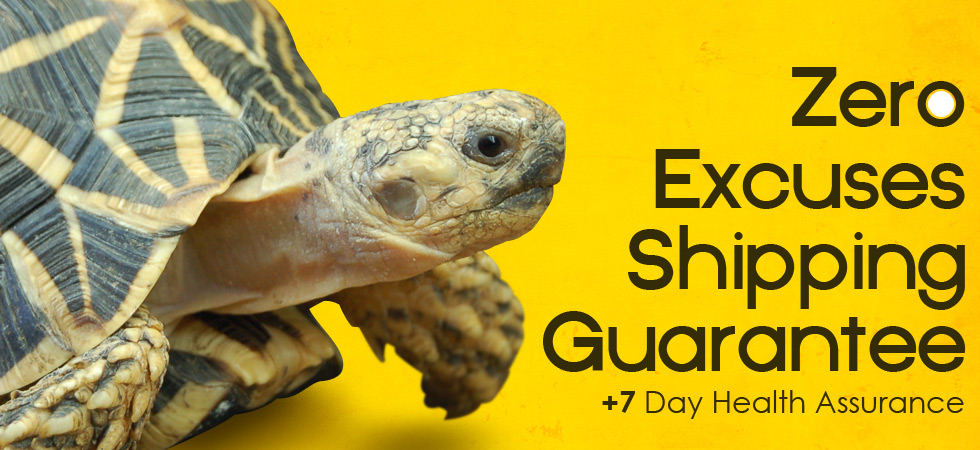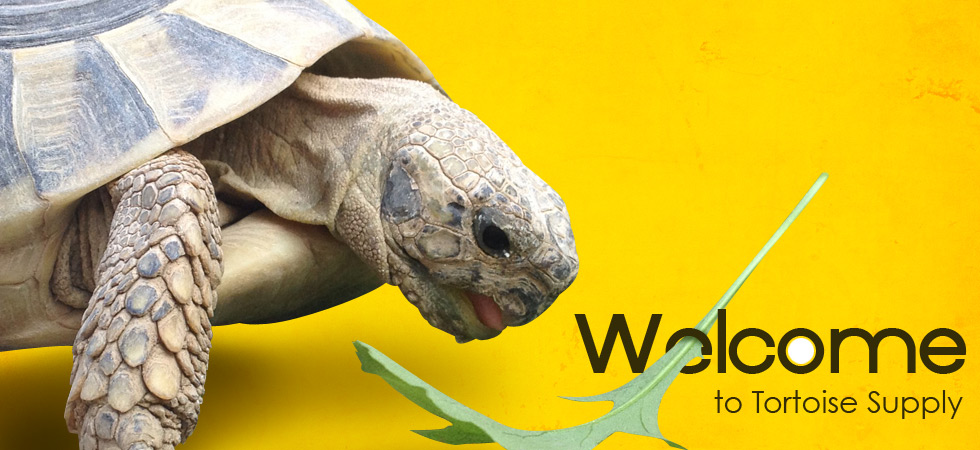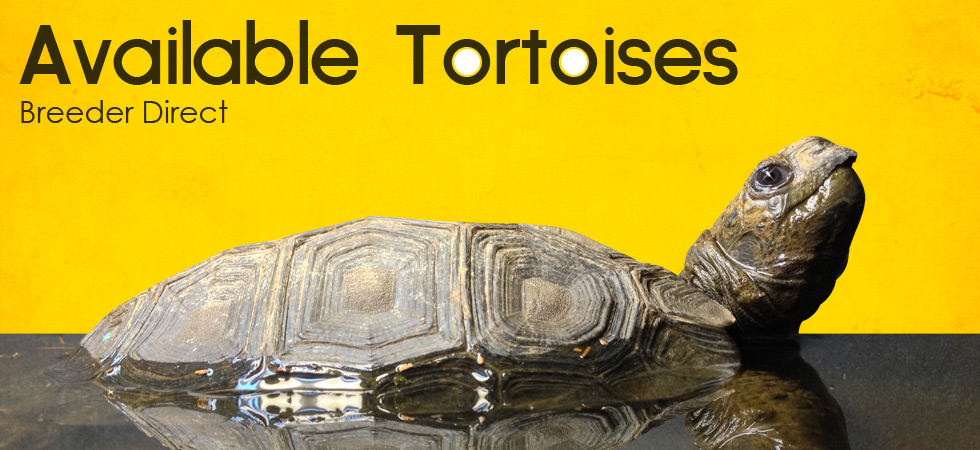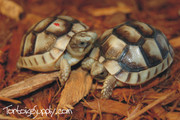Categories
- Tortoises For Sale
- Choose Your Exact Tortoise
- Lower Cost Tortoises For Sale
- Baby Tortoises For Sale (All Species)
- Pet Tortoises For Sale - 4" Size or Larger
- Egyptian Tortoises For Sale
- Greek Tortoises For Sale
- Hermanns Tortoises For Sale
- Leopard Tortoises For Sale
- Marginated Tortoises For Sale
- Pancake Tortoises For Sale
- Radiated Tortoises For Sale
- Redfoot Tortoises For Sale
- Russian Tortoises For Sale
- Star Tortoises For Sale
- Sulcata Tortoises For Sale
- Wholesale Tortoises
- Food Items
- Lighting
- Substrates
- Tortoise Kits & Cages
- Heat Mats & Heat Sources
- Cage Furniture & Bowls
- Supplements & Vitamins
- Seed Mixes
- Medical & Tools
- Books and Literature
- Waterland Tubs
- Toys & Gifts
- Shirts & Shipping Add-Ons
- Other Products
Greek Tortoise Care Sheet
Care sheet for the Greek tortoise (Testudo Graeca spp).
By Tyler Stewart
Written for use by Reptiles Magazine
The Greek tortoise (Testudo graeca) is a small species of tortoise ranging from about 5 inches adult size for the smaller subspecies up to 12 inches for the largest ones. It is native to a wide range of landscapes between southeastern Europe, western Asia and northern Africa. Because of its wide natural range, the tortoise inhabits a wide variety of environments and conditions, as well as temperature ranges, that exist in these habitats.
The Greek tortoise has also developed differences in appearance based on populations within different areas of its far-reaching range. Tortoises from the hotter, desert climates, for instance, are generally lighter in color, which helps them to shed heat naturally and to blend in better in sandy conditions. Those inhabiting cooler or higher-elevation climates tend to be darker in color to absorb more heat from the sun.
Because of this, the scientific community has separated the Greek tortoise into different subspecies based on their locales. These change regularly, however, which can make exact identification of individuals somewhat of a gray area in many regards. Over time, many Greek tortoises have been designated as something other than what they were originally named; in short, the tortoises didn’t change, but their subspecies may have.
Localities
As so much of the early founder stock of Greek tortoises in the U.S. was imported as Testudo graeca ibera and T. g. terrestris, these are the bulk of the Greek tortoises found in the U.S. at that time. Later shipments of tortoises originating from different locations were mixed into U.S. breeding groups by some keepers, and the lines between individual localities became blurred.
There is also a larger variation of what is technically T. g. ibera, and we keep a northern (darker) group separate from a southern (much lighter in color) group. Many private collectors and/or breeders don’t separate their animals this way, however, and other tortoises that have been imported more recently, which look very similar in coloration to both forms, were unfortunately mixed with the previously held T. g. ibera.
Caspian Greeks (T. g. buxtoni) from northern Iran have been considered T. g. ibera by some, but it is a distinct and notably smaller tortoise.
There’s a rare Greek tortoise subspecies from Libya, T. g. cyrenaica, that I believe was imported into the U.S. only twice. It experienced massive losses, so this Greek’s foothold in the U.S. is thin, making pure specimens quite valuable. I believe some breeders with a single T. g. cyrenaica are crossing them with similar-looking Middle Eastern Greek tortoises to produce their “Libyans,” so again, the lines get blurred.
The terms terrestris and graeca graeca are both widely used for very different-appearing animals from the Middle East and North Africa, and more specific scientific classifications are likely to come. As of this writing, there are about a dozen Greek tortoise subspecies. Some remain pretty consistent, while others are quite variable. The topic of Greek tortoise classification could be an article in itself, and it would still be outdated quite quickly.
Habitat
As mentioned, Greek tortoises inhabit a wide variety of environments in the wild. They can all generally handle cold and hot temperatures, and most (but probably not all) will hibernate in the wild naturally during the winters.
It is thought that T. g. ibera are somewhat better suited to colder environments than the more desert/arid types such as the golden Greeks or other Middle Eastern/African subspecies. I have friends and regular customers in the northeastern U.S. and other northern states who keep different types of Greeks, and they definitely struggle more with golden Greeks and the desert varieties than they do with T. g. ibera.
Availability
Greek tortoises were imported into the U.S. for many years, but less and less over the last few. They will generally arrive from a single country or collection area, so the tortoises in today’s shipments are usually from one subspecies or locale, but that’s not always the case. While animals within one subspecies may exhibit very different shell colorations, their shell shape, head scalation and other identifying traits will remain true to the subspecies.
Early on, many Greek tortoises that were imported were just labeled “Ibera,” so that’s what much of the base stock in the U.S. — likely originating from Turkey — was called. There were also some golden Greeks at the time that were initially from an unknown Middle Eastern location, and then many more recent shipments from Jordan and other Middle Eastern and North African areas.
Many of today’s imported Greek tortoises, unfortunately, don’t survive the stresses and parasite loads that they arrive with. Keeping Greek tortoises outdoors in large enclosures, in a setup as natural as possible, has worked pretty well to establish our breeding stock, but we did experience some losses that were difficult and unfortunate. At this point, we are mostly raising up captive-bred babies for future breeding stock, and we always have a few dozen young Greeks set aside for this purpose.
Captive breeding of Greek tortoises is proceeding full speed ahead within the U.S., and many are available annually from breeders who house them based on their subspecies, rather than in a mixed group. Different adult subspecies that are housed together will breed together, creating mixed-locale tortoises, and these can be difficult to identify because many different types have very similar characteristics. Unfortunately, many of these will be sold as pure locale types by breeders who don’t know better, or don’t care, and the purity of subspecies may be lost in future generations.
Greek tortoises aren’t usually as productive as some other Mediterranean species, such as the Hermann’s tortoise (T. hermanni). Their baby-per-year-per-female ratio is a little smaller, in our experience, and we are only producing a few types per year currently.
As Greek tortoise breeding can be very seasonal, many breeders will only have a certain type of baby available for a very brief period each year. Some tortoises bred in the southern states, or kept indoors, may experience longer breeding seasons than others, and so may be available longer than babies produced by tortoises in northern climates or others with a more drastic hot/cold seasonal change.
Outdoor Greeks
Here in Las Vegas, Nev., we are in the fortunate position of living in a place with a climate that works well for many tortoise species, and we are able to house our adult Greek tortoises outdoors all year. We house the different subspecies in side-by-side enclosures with little differences in their setup.
We are at an elevation of around 3,000 feet with yearly temperatures between about 20 degrees Fahrenheit for a winter low up to 120 degrees on a hot summer day. We have a relatively short winter during which the tortoises will bury themselves and hibernate from about mid-November through late February.
We house the different subspecies separately so there is no cross breeding. Most of the babies we produce are ground-hatched and identified based on the enclosures from which they originate.
Our Greek tortoise pens are formed from large areas encompassed by short, concrete block walls with a footing underneath. These areas are divided by removable wood walls, allowing us to adjust individual enclosure sizes depending on the size of the tortoise groups housed within.
We will typically bury about 4 to 6 inches of wall depth below grade and extend the walls to a 12-inch height to contain Greek tortoises. We will generally cap the corners so the tortoises can’t climb up the corners and escape, or get out by “laddering” themselves out by piling on top of each other. If escaping the enclosure means a tortoise would escape your property entirely, or be endangered by a dog or a pool, I would build the perimeter walls several inches higher to make them 100-percent escape proof.
We plant trees and tall shrubs on the south- and west-facing sides of the enclosures to provide summer shade over the bulk of the enclosure. In our climate, preventing tortoises from overheating is a bigger battle than trying to keep them warm enough. There are always sunny areas available if needed, but our tortoises spend most of the year seeking shade. We have wooden hide boxes in all the enclosures, in which they spend a lot of time, particularly during hot or cold weather. In the summer, we splash these down with water a few times per week, and they will maintain some moisture/humidity, as well as coolness, for a day or two afterward.
In the open area of the pens, we plant a lot of different types of clump grasses, several types of sage, rosemary and other safe, non-toxic, drought-tolerant desert plants. Prickly pear cactus pads are also grown in most of the enclosures, and the tortoises will occasionally eat away at the base of one of these, even to the point that the cactus tips over allowing them to eat it all.
Our Greek tortoises will usually leave their enclosure plants alone as long as they’re fed their prepared diet regularly, but I do like them to eat some of the plants to keep dry roughage in their diet. The trees we use are mostly mesquite, which are pretty and handle the heat well with very little water. They thin out in the winter, too, which allows more sunshine through.
Indoor Greeks
Greek tortoises can be kept indoors as adults if enough space is provided. How much space is enough is a common question without an easy answer. Tortoises in the wild are wanderers, and they like their floorspace. Giving them a 3-foot-tall enclosure does nothing for them; they want square footage, and they want environmental options.
For a minimum-sized indoor enclosure for a single adult Greek tortoise, I recommend one that’s about 8 square feet, though even larger would be preferable. Anything smaller and your tortoise will spend the majority of its day trying to escape from it. Adding a second tortoise would require an additional 10 or 12 square feet.
These size recommendations aren’t hard numbers, and cage setup and furniture makes a big difference (so the tortoises can attempt to establish their own space), but always keep in mind that tortoises want more space than you are ever going to be able to give them indoors, and so do what you can to give them that. Tortoises of any species aren’t great indoor pets, to be honest.
Greek tortoises kept indoors should have powerful lighting over them, including both a UVB source, such as a Zoo Med Reptisun 10.0 tube light, in combination with a heat light for a basking spot at one end of the enclosure that is somewhere around 100 degrees Fahrenheit at ground (or tortoise) level. We have also used a single mercury vapor bulb (which puts out heat, light and UVB all in one) with great success over both babies and adults that were temporarily indoors.
Baby and juvenile Greek tortoises can do well in much smaller enclosures than the adults. We start babies in enclosures that are about 18 by 24 inches in size (roughly 3 square feet) in which they can find both cooler and hotter areas, as well as moist and dry, and an enclosure this size still allows the tortoises space to get away from each other.
Adult Greek tortoises basically want the same things, but on a larger scale. Babies in the wild spend almost all of their time buried or snuggled into a tight little microclimate, which they leave only for brief periods to eat and explore. They are so vulnerable to predators and environmental extremes that their natural instincts don’t allow them to be big risk takers. As such, baby Greek tortoises in captivity will spend the bulk of their day hiding in a moistened, tight little hide that you provide them, positioned somewhere between the warmer and cooler ends of the enclosure (multiple hides in different temperature zones will give them the options they want).
We generally house baby and juvenile Greeks on coco coir, a clean cypress mulch substrate, or some combination of the two. We have also used clean peat moss with good success, though it can be difficult to find all the babies for their daily soakings, and peat moss slightly tints the babies black due to the dark color of the peat (which washes off; it just makes them look dirty in the meantime).
A light layer of grass clippings or dry hay can be placed over the top of the substrate to provide some cover. Be sure there is no mold present, as dry hay can become moldy if it’s placed on a moist substrate, and the substrate should be kept slightly moist via misting.
Group Housing
We have had great luck keeping multiple Greek tortoises in groups without any complications or major fighting, other than minor skirmishes during the breeding season. Many keepers routinely advise against housing Greek and other tortoise species in groups, but it can be done. Problems typically happen when tortoises that have been housed alone for some time are placed in a group. We rarely acquire individual tortoises and put them with a group, but many people do, and these are usually the “problem animals.”
When we raise baby tortoises for future groups they are always housed in groups. We don’t separate them from each other ever, and I think this helps them keep getting along, establish a pecking order, and live peacefully in groups long term. There are some tortoises out there that are just brats, and are not suitable to be housed in groups, and those are probably best kept by someone who wants a single tortoise as a pet. I don’t think a tortoise that is housed in a group should ever be separated to prevent potential aggression. Isolating that tortoise will likely make it aggressive. Separate a constantly aggressive tortoise if you have to, but don't do it unless it's become a problem. Again, minor skirmishes are normal and healthy for tortoises.
Greek Food
Greek tortoises eat a wide variety of foods in the wild; within their wide range of environments and geographical locations, it’s likely as big of a variety of any tortoise out there.
In captivity, Greek tortoises do well on a typical tortoise diet of coarse, leafy greens, dry leaves such as mulberry or grape leaves, and other non-toxic plants. For our Greeks, we stick with endive and other dark, leafy greens, going heavy on dandelion greens, along with some red or green leaf lettuces as a good supplemental food.
I chop a mixture of these items in a 5-gallon bucket, mix them well, and then dump in some moistened commercial tortoise food, such as Zoo Med’s grassland tortoise food. I mix everything up thoroughly so the commercial food, along with all its vitamins and added ingredients, coats the greens. This results in it being eaten because the tortoises are unable to avoid it.
We will also throw in a handful of our “herbal hay,” which we make ourselves from a mix of dozens of herbs and flowers in a dry form that adds a lot of variety and flavor/scent to the tortoise food (it’s available on our website).
During the egg-laying season, or when feeding babies, we add powdered calcium to the above-mentioned mix.
Everything gets mixed well, and this diet is offered to all our tortoises. We use the same base diet for about 80 percent of them, from babies to adults. In addition, the adult tortoises that are kept outdoors eat leaves and plants from the vegetation that is growing in their outdoor enclosures.
A healthy tortoise doesn’t need to eat every day, but we do feed babies daily to keep their metabolisms going full speed. The adult tortoises can always graze on items in their enclosures if they want to eat on the days we don’t feed them ourselves.
Food should be offered on a clean surface, such as a plastic tray, a flat stone or a dish of some sort. Dirt and sand will stick to fresh tortoise foods, can be accidentally eaten and will accumulate inside a tortoise’s gut. Many people feed their tortoises from a piece of slate tile or rock, as eating from a rough surface such as these will maintain a healthy tortoise beak over time.
A Refreshing Drink
Adult tortoises should have water available to them at all times. We have water bowls in our outdoor tortoise enclosures that we clean and fill up to four times a week or as needed (they dry out within 24 hours in the Las Vegas summers).
In the summer, the tortoises will eagerly drink from them immediately upon our placing the refilled bowls in their enclosures. Adult Greek tortoises are good at maintaining moisture, but when it’s really hot, we do keep water available at all times.
Indoor enclosures are typically less dehydrating, plus water bowls in indoor enclosures generally get dirty very quickly. As an alternative to keeping them in the enclosure, we soak indoor adult tortoises manually once or twice a week.
We have had baby tortoises flip over and drown in very low-sided, shallow water pans or bowls, so we no longer use these. Instead, we remove babies from their enclosure once a day and soak them in a shallow plastic tub for 15 to 20 minutes. While they are soaking, we straighten up their cage, add some moisture to the substrate if needed, and set their food out. If you keep groups of baby Greek tortoises together, place the smaller ones in front of the food in their enclosure before the larger ones are returned so they can eat their fill without the stress of their larger siblings or other tortoises being around. Over time, this should help smaller tortoises increase in size.
Maintaining moisture in the substrate is an important part of keeping baby Greek tortoises properly hydrated. They will lose a lot less moisture if they are kept in a humid microclimate, and they will dry out very fast without one. Dehydration is a major killer of baby tortoises, and preventing this needs to be a top priority.
Greek tortoises are great tortoises for new or experienced tortoise keepers. Their small size and tolerance to high and low temperatures make them easy tortoises for people to keep in a wide variety of climates. Out here in the desert, they are definitely one of our favorites!
Featured Products
-
$800.00

-
$250.00

-
$250.00

-
$180.00

 Loading... Please wait...
Loading... Please wait...








